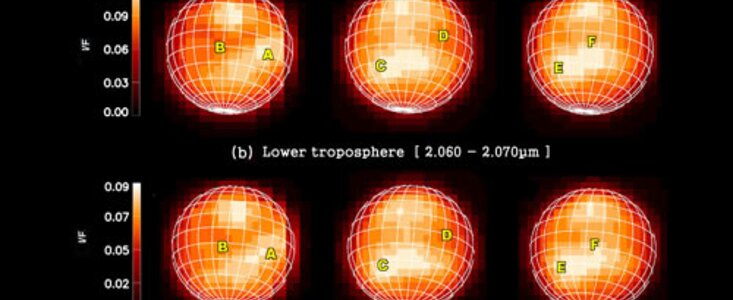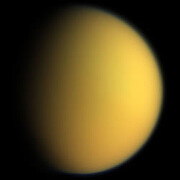Does Methane Rain Down on Titan?
16 May 2008
A team of astronomers has used infrared spectral images of Saturn’s moon, Titan, acquired with the Gemini North Frederick C. Gillett Telescope, to dispute an earlier claimed detection of widespread morning methane drizzle.
Titan, the second largest moon in the solar system, has long fascinated astronomers because it is the only moon in the solar system with a thick atmosphere. Adding to the fascination, its cold atmosphere (94 K or -180º C near the surface) has a number of interesting similarities to our Earth’s atmosphere. For example, its complex temperature profile (temperature vs. altitude) has the same overall structure as Earth’s and the atmospheric surface pressures are nearly the same. Also like the earth’s atmosphere, nitrogen is the dominant chemical species.
After nitrogen, methane is the most abundant chemical species in Titan’s atmosphere. It has sometimes been said that methane plays the same role in Titan’s atmosphere as water does in ours. At low altitudes the temperatures and pressures in Titan’s atmosphere are close to those in which methane can condense into liquid form. During the last several decades there has been considerable speculation among astronomers as to whether or not Titan contains seas of liquid methane and whether or not methane actually rains onto the surface.
The marvelous images of Titan provided by the Cassini Mission and its Huygens probe, (which parachuted to the surface of Titan in January 2005), have revealed that seas are not present. However these images show river channels and what appear to be small lakes–suggesting that liquid methane does exist on parts of the surface. Meanwhile ground-based monitoring of Titan at Gemini and other large telescopes has revealed shifting cloud patterns and the occasional formation of thick and highly localized clouds. Thus, conditions seem ripe for precipitation.
Recently a team of astronomers at the University of California at Berkeley led by Mate Adamkovics reported direct detections of methane drizzle over a large region of Titan. The detections were based on comparisons of infrared images of Titan made in 2005 at the Very Large Telescope and in 2006 at the W.M. Keck Observatory on Mauna Kea. These observations were made in two wavelengths ranges in which Titan’s atmosphere is semitransparent, but in one of which condensed methane is believed to absorb more strongly. In each case the UC Berkeley team found evidence for extra absorption, which they attributed to small methane droplets, on the side of Titan that had recently been exposed to sunlight. The location led them to suggest that they had detected morning drizzle and that it is a diurnal phenomenon.
Independently a team of astronomers including Professor Sang Joon Kim of Kyunghee University, Korea, Laurence Trafton of the University of Texas, and Tom Geballe at Gemini Observatory (Gemini North), who were interested in studying other aspects of the atmosphere of Titan, used Gemini North’s integral field spectrograph, NIFS, and the adaptive optics system Altair to study that moon. On three dates in 2006 they acquired a detailed set of infrared spectral images covering all of Titan and including the wavelength ranges observed by the Berkeley team. The Berkeley finding sent them scrambling to examine their data for the same phenomenon.
Using the same comparison technique as the Berkeley team they too found regions of apparent excess absorption at some locations on Titan. However, in their data set, these regions, (some of which were the same as seen by the Berkeley team), were now afternoon locations and also were locations on which the surface of Titan is bright (i.e., more highly reflecting of incident sunlight). Kim’s team also found that excess emission tended to be correlated with regions on Titan where the surface is darker.
This sort of anti-correlation suggested that the comparison technique was flawed. Kim’s team made a detailed study of the technique and found that it is very easy for it to produce difference images with spurious bright and dark regions. In their work, just published in Astrophysical Journal Letters, they conclude that there is no spectroscopic evidence for widespread methane drizzle or that such drizzle is a morning phenomenon. This does not mean that drizzle does not occur, but rather that remote detection of it, particularly via this technique, is much more difficult than first thought.
In their paper Kim, Trafton, and Geballe also point out that clouds, localized haze, and even differences in Titan’s surface geography likely complicate the detection of methane rain. Thus, although monitoring Titanian rainfall from Earth is an intriguing possibility, considerable additional observations and analytical work will be needed to investigate under what conditions the signature of methane drizzle can be extracted unambiguously from images of Titan.
Background Information
Titan is Saturn’s largest (and 20th most distant moon), it is second only in mass to Jupiter’s Ganymede in our solar system. Titan has a diameter roughly 50% larger than the Earth’s moon and measures 2576km in mean radius. It was discovered by the Dutch astronomer Christiaan Huygens in 1655 and was the first known moon of Saturn which is now known to have at least 60 confirmed satellites.
Titan’s remarkable atmosphere is about 98.4% nitrogen and 1.6% methane. It orbits Saturn about once every 16 days and has a mass just over 2% that of the Earth.
Titan is visible through relatively small telescopes (and powerful, high-quality binoculars). Saturn and Titan are currently visible in the evening sky (May 2008).
For more details, read the article “No Evidence of Morning or Large-scale Drizzle on Titan,” by Sang J. Kim, Laurence M. Trafton and Thomas R. Geballe in the May 20th 2008 edition of ApJL 679, L53-L56.



